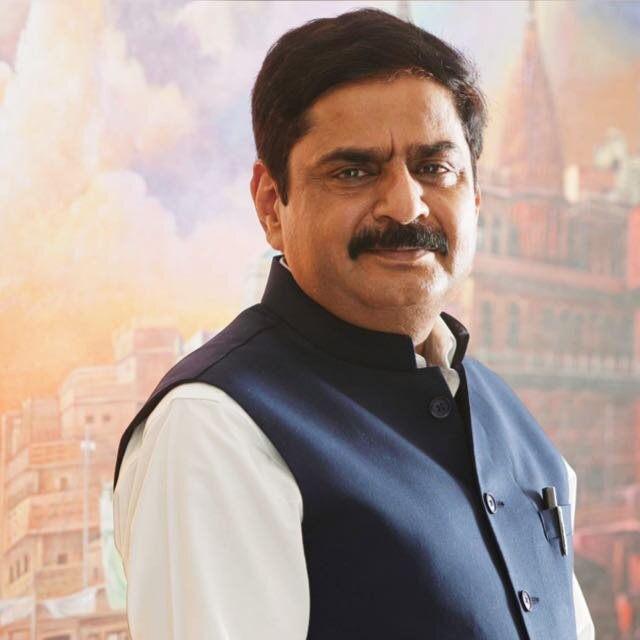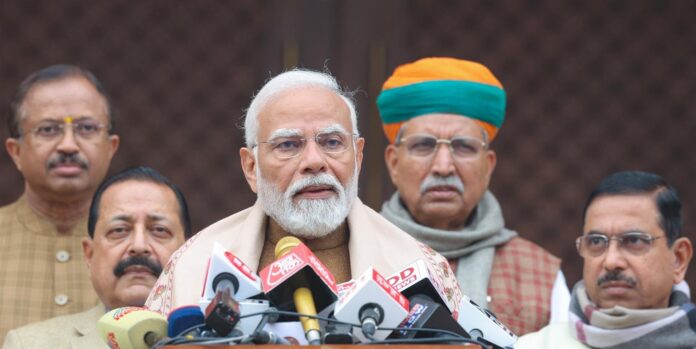Through his motivational leadership, PM is not only serving the Nation but leading the World too
He is the first leader to weave narratives of the future in his governance vision
Working tirelessly to fulfill the dreams of rising India

Jitendra Tiwari
As the Modi government completes it’s consecutive second term in office and destined to win the upcoming Lok Sabha elections with flying colours, it has helped raise India’s global stature and pushed for inclusive development. In
Narendra Modi, the people of India see a dynamic, decisive and development-oriented leader who has emerged as a ray of hope for the dreams and aspirations of more than a billion Indian. His focus on development, eye for detail and efforts to bring a qualitative difference in the lives of the poorest of the poor have made Narendra Modi a popular and respected leader across the length and breadth of India. Modi’s life has been a journey of courage, compassion and constant hardwork. At a very young age he had decided to devote his life in service of the people. That relentless commitment still the guiding force of his personality. It is because of this driving force, Modi often evokes images of the future and ties them with the hopes and aspirations of the common people in his speeches. He is the first leader to weave narratives of the future in his governance vision.
Modi’s leadership, based on the core principle of ‘Sabka Saath, Sabka Vikas, Sabka Vishwas’ has enhanced India’s stature and made him a global icon. His journey in public life has been marked by an unwavering commitment to social service, national development, and the welfare of the less fortunate. Every moment of his life, every atom of his being, has been dedicated to these noble causes.
Narendra Modi’s evolution from quintessential Organization Man of the BJP to one of India’s best known leaders recognized for his Good Governance over a span of a decade tells a story of grit, determination and Strong Leadership in the face of grave adversity. Narendra Modi’s transition from the world of Political Organizing to the realm of Administration and Governance neither had the luxury of time nor the benefit of training.
benefit of training. Modi had to learn the ropes of Administration while on the job right from Day One. Narendra Modi’s days in office offer a glimpse of not just how he made that personal transition but these days also offer a glimpse of how Modi brought unconventional thinking and out of the box ideas to shake status-quo and reform Governance.
In 2014, when he took over the reign of the country from a lethargic regime, the nation’s moral was at it’s all time low. There was an atmosphere of despair in the country and a policy paralysis because of the then prime minister, who remained quiet on crucial issues. The main reason behind the “despair” prevailing in the country was that nobody takes responsibility. Owing to policy paralysis India had become a country of “under-achievers” due to lack of planning and there was a need to come out of this situation by building an atmosphere of trust. In those atmosphere of disgusting and disappointing circumstances, there came a government with purpose of revolting against all types of odds. Modi transformed the country’s mood from despair to optimism. Since then India’s economic rise over the past decades has been a remarkable event, lifting tens of millions out of abject poverty and creating a solid middle class. It is a story of success is being clearly reflected on Face of common people.Prosperity has been spreading across the country. Indians despair over the state’s inability to deliver the most basic public services – law and order, education, health, and clean water started shrinking with Modi’s innovative policy implementation spree.
As I look back on our more than 75-year history as an independent nation, I can discern three great milestones: in August 1947, India won political freedom; in July 1991, it gained economic liberty; and with the election of Narendra Modi in May 2014, the emerging middle class attained dignity. The landslide victory of Modi, the son of a chaiwalla (tea seller), invited us to broaden our conception of human dignity and question our prejudices. Modi’s success affirmed, for the first time in India’s history, the aspirations of millions who had pulled themselves up into the middle class through their own efforts in the post-reform decades after 1991. It forced us to challenge our bias against the petit bourgeois – kiranawalla (shopkeeper), paanwalla (betel-leaf maker), auto-rickshawalla (rickshaw driver) – and other occupants of the street. The idea that anyone can aspire to the middle class is the new master narrative of our society. It is also with this impatient class that the hope for governance reform lies.
Many Indians hope that, in Modi, they finally have someone who can enhance the state’s capacity to act. However, reforming state institutions is much tougher than reforming the economy. Modi recognised this problem when he promised “minimum government, maximum governance”. He vowed to create an enabling environment that would allow people to do business without stifling red tape and the notorious “inspector raj”. He is still doing the same with much stronger zeal.
Natural resources, such as mines and spectrum, are now being auctioned transparently online.[2] The campaign to improve the ease of doing business is reportedly slashing clearance times and creating healthy competition between the states. The process is being aided by digitising all data and posting it on public websites, making transparent which file is held where. The proposed official ranking of states on different aspects of doing business will soon expose the laggards. Modi has un-gummed the central bureaucracy and broken the paralysis at its core. In the event that Modi wins a consecutive third term, he may be able to mobilise middle-class anger against bad governance and reform institutions.
Many renowned psephologists have predicted Modi’s third term win in 2024 elections. They’re of opinion that Modi government will repeat it’s 2019 performance in upcoming lok sabha polls. Their prediction is based on various welfare measures taken by his government, such as, provision of toilets for women, opening of bank accounts and water connections for the weaker sections provided by the Modi Government since 2014.
Factors in favour of Modi government which will bring it to power in 2024, according to noted economist Arvind Panagariya. Since it came to power at the Centre, the Modi government has delivered on many of its electoral promises announcing a slew of schemes targeted at those at the bottom of the pyramid according to Panagariya.
* Swachh Bharat Scheme floated by Modi government has been a crucial driver of change;
Government data indicates that under the Swachh Bharat Mission, 6.281 million toilets have so far been constructed across households along with over 600,000 community toilets, and around 4,355 cities having been declared free of open defecation.
* Opening of Savings bank accounts under the Jan Dhan Yojana, the Aadhaar unique identity number, and the mobile phone, the trinity, JAM has proved to be a very powerful instrument in facilitating Direct Benefit Transfers (DBTs) of welfare subsidies into the bank accounts of the poor, and reducing corruption;
Government records indicate that around 480 million bank accounts have been opened under Jan Dhan Yojana.
* An important policy intervention of the Modi government according to Panagariya has been the Nal Se Jal scheme aimed at providing potable water connection to every household by 2024. About Rs. 3.60 lakh crores have been allocated for the programme & reportedly over 30 million rural households have been provided functional tap water connections with a target to cover the remaining households by 2024.
According to Panagariya, these schemes directly benefit women who have been increasingly coming out to vote, and are also determining how their households vote.
Modi’s Push for 100% saturation of government schemes
In his Independence Day speech in 2021, Prime Minister Narendra Modi had called for 100 % saturation of government schemes involving six key initiatives:
*. Ayushman Bharat Scheme offering free medical insurance;
*. Ujjwala Yojana offering free LPG connections;
*. Twin life insurance schemes, PM Suraksha Bima Yojana (PMSBY) & the PM Jeevan Jyoti Bima Yojana (PMJJBY) backed by the government;
*. Atal Pension scheme;
*. PM Housing Scheme; and,
*. Har Ghar Jal Scheme for drinking water.
Out of these, Ayushman Bharat and Har Ghar Jal have so far shown some impact on the ground during PM Modi’s second term, which, according to observers, is likely to be reflected in the 2024 Lok Sabha election.
Modi government’s Achievements on the External front
On the external front, Narendra Modi has not followed any of his predecessors, but has charted his own path which is practical & in sync with the emerging world scenario. The enlightened urban electorate realise the importance of these steps that have catapulted Narendra Modi to the rank of a world leader.
The policy followed by Narendra Modi government on the external front
* The Act East Policy & Neighbourhood First Policy towards immediate neighbours in South Asia & South-East Asia & Japan in East Asia;
* Outreach to India’s maritime neighbours in the Indian Ocean Region to counter Chinese designs;
* Charting an Independent foreign policy without succumbing to the western powers.
Following an Independent foreign policy, PM Narendra Modi has demonstrated to the world that India has emerged as a world power, which has been widely acknowledged by the world.
Looking at achievements of the Modi government, both on the domestic as well the external front, he does not seem to have any alternative at present.
Opposition Challenge?
The splintered opposition posing a challenge to Narendra Modi in the 2024 Lok Sabha election seems improbable looking at the ambitions of various opposition leaders to emerge as a combined opposition candidate to face Narendra Modi in 2024.
Even Rahul Gandhi’s much hyped Bharat Jodo Yatra is not likely to provide rich dividends to the party for obvious reasons. Rather, Congress may have to pay heavily for the gaffes of Rahul Gandhi.
On the contrary, Narendra Modi has proved his mettle impressively on both domestic & external front, raising in the process the stature of the country internationally. In fact, as of today, the Opposition has no leader of Modi’s stature, one who can challenge Modi’s popularity & statesmanship. This thus makes him the one of his kind. It is in the interest of the country that Modi gets at least one more term in 2024 to complete the unfinished work. Expert psephologists prediction about Modi returning as PM in 2024 therefore seems plausible.
(Writer is President, All India Iffco Officers Association)


